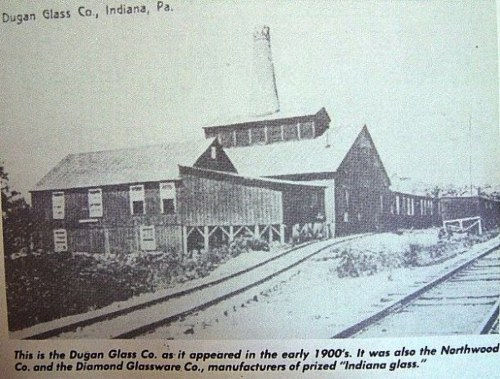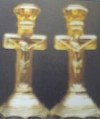Carnival Glass 101 | home Quick Reference to Carnival Glass Patterns
More Dugan
Note: The following article is a reprint from an undated Keystone Club newsletter we found in some old files. Dennis Keck is known to have been an active club member in the mid 80s. Reference is made to a second part of this article. Regretfully, we cannot supply that portion. We hope you will enjoy reading the factual history related here
.
Dean & Diane Fry~~10/26/03

A LOOK AT THE DUGAN
GLASS PLANT
* This offers a glimpse of the glass plant at Indiana, PA. It is a reprint from the Indiana Gazette from July 28, 1984. This was submitted by Dennis Keck, a member from Punxsutawney, PA. We are grateful to Dennis for this fine educational contribution.
Glass plant flourished as top industry in area
By CLARENCE STEPHENSON
Gazette Contributing Writer
Glasses, vases, candy dishes and many other items made of glass in colors ranging from white to pastel pink, blue, green, amber or, occasionally, red, are found in many Indiana homes today and in other places throughout the United States, Some people know and recognize such glass treasures as "Indiana glass," but there are probably others who have Indiana glassware in their homes without being aware of their value and significance. People have been known to pay high prices for glassware at auctions and flea markets, thinking it to be made in West Virginia or Ohio, when in reality it is Indiana glass.
The story of Indiana Glass began on Jan. 1, 1892 when a group of Indiana leaders gathered in the office of attorney and former State Senator George W. Hood to consider a proporal by Mr Nevill, a visiting glass expert who had patented glass molds which he claimed would reduce the labor required and increase production by a third to a half.
Mr. Nevill urged the erection of a factory to manufacture glass in Indiana. He felt that here he would not encounter the antagonism of labor unions which in the larger cities had opposed his labor-saving ideas.
The result of this meeting was that $12,000 was immediately pledged to the stock of a company. The Indiana Board of Trade shortly afterward visited the West Penn Glass Company, then under construction in Blairsville. Upon returning to Indiana, additional stock to the total amount of $35.000 was pledged.
The company was formally organized Jan. 28, 1892, with the following directors: Harry White, W.B. Marshall, Griffith Ellis, Thomas Sutton, John S. Hastings. H.W. Wilson, and Delos A Hetrick. Harry White was elected president and the authorized capital stock increased to $50,000.
By Feb. 17 it was announced the factory would be located on the old State Experimental Farm (at what is now the parking lot adjoining Miller Stadium). Incorporation as the "Indiana Glass Company" followed on April 14, 1892.
In May the contract for a frame building 80 x 219 feet with an iron roof, was given to John S. Hastings - to be completed by Aug. 15. A new railroad siding was put in by J.H. Caldwell and J. S. Hastings. A 130-foot deep well provided water.
Production began Monday afternoon, Nov. 14, 1892, following a speech at 2 p.m. by Judge Harry White. Afterward citizens were invited to view the plant. The first superintendent was S.W. Vandersaal. He was succeeded by Griffith Ellis for about a year.
Things did not go well at first. By 1894 the company was in debt and had to shut down. A meeting of the stockholders was held in July and at that time it was learned that only $34,800 of the capital stock had been paid in. The cost of erecting and equipping the factory had been $29,000. Operating expenses until the time of closure were almost $14,000 Indebtedness was about $11,000, Manufactured glasswares on hand were valued at $2,200 and accounts receivable were $700, leaving a net indebtedness of $8,100.
A committee was named to recommend plans for liquidating the debts and resuming production: J. W. Sutton, Griffith Ellis, S.L. Loughry, John Hastings, and J. H. Young. Their report was gloomy. The glass factory, they said, was "a failure financially" and it did not appear possible to procure more working capital, Further, because "many similar plants are idle and can be bought for a small fraction of their value" it was doubtful whether it could be sold "for even its present indebtedness."
The committee recommended leasing the plant rent free for a year with the option of buying at the end of the year for the amount of accrued indebtedness. This was adopted by the stockholders, but the works continued to be idle for about two years.
Finally in February 1896, Harry Northwood leased the plant. He was a successful owner and operator of two other glass plants, and imported from those plants a number of skilled glassworkers. The name of the company was changed to Northwood Company. Production resumed on March 25, 1896. As plant manager, Northwood employed Thomas E.A. Dugan who had come from England to the United States. Under Mr. Dugan's skilled management the glass business in Indiana prospered during the 19 years that he lived here.
In February 1897, Mr. Northwood was considering moving the plant to Blairsville. A newspaper item at that time reported that he had requested the Indiana Borough Council to install a fire hydrant at the plant some six months previously, but council hadn't bothered to answer. He was free to leave, Mr. Northwood asserted, because "I have not yet purchased the Indiana plant." This "persuasion" movitated council to install the fire hydrant.
In March 1897, the plant shut down for a week while a new furnace was installed and it was reported "Manager Northwood is well satisfied with the arrangement of council for a fireplug near the works. and now comes to the front with another proposition which bears the earmarks of fairness.
Many of the employees of the works, in order to get to the plant by the most direct route, have to tramp through mud, ankle deep in some places, in traversing the streets back of Normal. Mr. Northwood has built a cinder path from the works to the borough limits and offers to furnish cinders free of cost to the council if they will build the walks over the much needed places in the borough.
During the last month the plant paid out about $5,400 in wages. Last Saturday's was the largest pay in the history of the plant, the payroll amounting to $3,100.
In February 1898 it was learned that Northwood had arranged to buy the plant for $8,000. Of this sum he agreed to contribute $3,000. A committee of the Board of Trade had canvassed and secured between $4,500 and $5,000. It was made a condition of the sale that Northwood remain and operate the plant for three to five years, at the end of which time he would receive a clear deed. The factory at this time was running night and day, and employed 225 persons men, boys and women.
Announcement was made In July 1899 that the factory would be enlarged and shortly thereafter on Sept. 4, the company was sold to the National Glass Co. of Pittsburgh. Northwood was associated with National Glass for a time, residing in England where he managed the London office.
In 1902, Mr. Northwood liquidated his interests in National Glass Co., and went to Wheeling W.Va., where he established another glass factory.
On June 16, 1903, National Glass Co. entered a float in the Indiana County Centennial parade on which was displayed all kinds of glassware, and many little glass chains which kept up a merry jingle as the wagon was driven over the streets. Fifty-four glass workers walked before the float carrying glass canes.
In January 1904, National Glass Co., having experienced financial difficulties, was sold to Dugan Glass Co. for $45,000. The transaction included $32,000 worth of glassware in stock. Dugan Glass Co., named for Thomas E.A. Dugan, was a stock company with $50,000 capital headed by John P. Elkin, president; Clarence R. Smith, Treas.; Dugan, superintendent; and A.S.Cunningham, J.O. Clark, D.B. Taylor and D.C. Mack, directors.
By 1907 Dugan Glass Co was said to be the largest industry in Indiana The "New York Industrial Recorder" gave the following account:
The Dugan Glass Co. ... (is) an immense plant. modernly equipped, covering seven acres and connected by switches with the PRR Co. and BR&P tracks. A force of 200 skilled workmen is employed.
This company manufacturers the world famous Diamond "D" crystal, colored and opalescent glassware in table, lemonade and wine sets, vases, novelties, lamps, toilet bottles, etc., and originated the celebrated "Klondyke," "Louis XV," "Pagoda," "Nester," "Victor," "Venetian," "Japanese," and other equally popular lines in intaglios and filigree work. They ship all over the world and have representatives in New York, Boston, Philadelphia. St. Louis, Baltimore, Chicago, Buffalo and London, Canada, as well as in many foreign cities. Their output amounts to about $175,000 a year.
The article said that Mr. Dugan was treasurer and general manager "and to his ability, experience and wide acquaintance, the success achieved is largely due."
The ingredients for glass making were sand, lime, soda and special coloring substances. These were put into ten iron pots arranged around a circular gas-fired furnace. When the mixture had melted, a gatherer removed the molten glass by inserting a long steel bar with a knob on the end. When enough molten glass had adhered, he took it either to a blower who blew it into various shapes, or to a presser, depending on the shape of the molten glob. The presser's job was to compress the glass into various forms using a mold with a hand-operated lever.
A snap-up man removed the glass with a clamp-type device called a snap and returned it briefly to the heating process, then took it to a finisher for special touches. Carry-over boys brought the glass to a lehr - a 65 foot conveyor belt - for final cooling, inspection, counting and packing. The latter work was done by women who relegated imperfect pieces to the scrap barrels for reheating. Barrels were made by coopers in the basement.
There was also a decorating room where women polished pieces and applied paints free hand in flower and leaf patterns, also gold rims on glasses. In the cutting section men etched fine designs into other pieces, using carborundum stones.
Wages were as low as 17 cents an hour for beginning women, and ranged up to $6 a day for skilled blowers and decorators. The work in the furnace area was extremely hot. Some employees commuted by streetcar from Ernest, Homer City and other points along the streetcar lines. There was an annual summer layoff during which repairs were made on the furnace.
An early morning fire on Jan. 31, 1912, destroyed the mold shop and a large quantity of expensive patterns - also the cooper shop and straw shed - at a loss of $20,000 to $25,000. The straw was used for packing the glassware in the barrels for shipment by rail.
In 1915 the company was sold to the Diamond Glassware Co and Mr. Dugan left at the time. During the World War I years (1914-1918), business boomed due to the closure or destruction of many European glass factories. Orders were booked months ahead, and still some orders had to be turned down. In 1916, the monthly payroll was $16,000.
The officers of Diamond Glassware were J.R. Richards, president; D.B. Taylor, treasurer; H. Wallace Thomas, secretary and superintendent. The board of directors included H.E. Clark Jr., J.O. Clark, C.R. Smith, J.A. Crossman, A.S. Cunningham and W.G. Minnemyer.
After the war, business declined somewhat but continued reasonably good until 1930 when the effects of the Depression began to be felt and the employees were put on part-time employment. On March 10 and 11, 1930, the company's products were exhibited at the "First Annual Manufacturers' Exhibit" in the Moore Hotel. A brochure stated "Largest of Indiana's manufacturing plants is the Diamond Glass-Ware Company, which last year employed 185 to 240 people. Its products are distributed throughout the United States and also in Australia and the West Indies."
Disaster struck on June 27. 1931, when fire destroyed the stockroom and $30,000 worth of finished glassware, the decorating room, packing room and office. The loss was estimated at $100,000. This blow, and the Depression nationwide, proved to be too much. In spite of talk after the fire that rebuilding would be done, the plant never resumed operation, After standing idle for a number of years, the remaining building were razed.

back to Carnival Glass 101
Should you care to contact the Frys, their email address is:
Search Carnival Glass 101
Our other sites you may enjoy:
Everything you EVER wanted to know about Indiana Glass
Great Reference for Newer Carnival Glass.
Complete Glassware Catalogs Available to Download
Questions? Comments? Suggestions? Broken Links? Corrections?
Your Friendly Webmaster is here to help!
